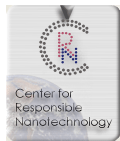PRESS RELEASE: MAY 17, 2005
Nanotech: Moving
Closer to a Manufacturing Revolution
Nanotechnology's long-expected transformation of
manufacturing has just moved closer to reality. A new
analysis of existing
technological capabilities, including proposed steps from today's nanotech to
advanced
molecular machine systems, was released today by the Center for
Responsible Nanotechnology.
The study, "Molecular
Manufacturing: What, Why and How," performed by Chris Phoenix, CRN
Director
of Research, is available online at Wise-Nano.org. It shows how existing
technologies can be
coordinated toward a reachable goal of general-purpose
molecular manufacturing.
"Molecular manufacturing offers a fundamentally new approach to build things
'from the bottom up',"
said Phoenix. "The idea is to use nanoscale machines to
create structures with atomic precision.
Ultimately, that can result in the
ability to make complex products, both small and large, with
unprecedented
performance and value."
Theories and concepts for molecular manufacturing, first
proposed in the 1980's
by nanotechnology pioneer K. Eric Drexler, have improved steadily since then.
But
recent progress is occurring at a faster pace. Less than two years ago,
Phoenix published the first detailed
architecture for a "nanofactory," a
remarkably powerful general-purpose manufacturing appliance
that could sit on a
desktop. Since then, Drexler, working with John Burch, has developed an improved
design
that should be significantly more efficient.
Recent developments in DNA synthesis and polymer
construction, plus advances in
miniaturization and precision of scanning probe microscopes, are rapidly
adding
pieces to the nanotech jigsaw puzzle.
This new study puts the pieces in place. Presenting
research performed by CRN
under a grant from NASA's Institute for Advanced Concepts, while also updating
and
combining existing work in related fields, it describes a newly simplified
way to develop molecular
manufacturing starting with today's technology.
Phoenix describes two approaches for building the initial basic tools with
current technology. Other sections
outline incremental improvement from those
early tools toward the first integrated nanofactory, and analyze a
scalable
architecture for a more advanced nanofactory. Product performance and likely
applications are
discussed, as well as incentives for corporate or government
investment in the technology. Finally,
considerations and recommendations for a
targeted development program are presented.
"We've done an end-to-end analysis of molecular manufacturing's goals as well as
some ways to get
there," said Phoenix. "More important, this study shows that
development of the technology will be
both highly desirable and relatively
straightforward. It's probably not as far away as many people think,
which means
it's time to begin discussing the ramifications, both positive and negative."
"Molecular
Manufacturing: What, Why and How" does not directly address the societal,
environmental, medical,
economic, military, security, and geopolitical
implications of the technology's introduction. However, those
topics are
explored in other papers and
articles on
CRN's website.
Other resources:
 "Design
of a Primitive Nanofactory" (Phoenix)
"Design
of a Primitive Nanofactory" (Phoenix)
 "Productive
Nanosystems: From Molecules to Superproducts" (Drexler/Burch)
"Productive
Nanosystems: From Molecules to Superproducts" (Drexler/Burch)
 "What
is Nanotechnology?"
"What
is Nanotechnology?"
 "What
is Molecular Manufacturing?"
"What
is Molecular Manufacturing?"
 "Thirty
Essential Nanotechnology Studies"
"Thirty
Essential Nanotechnology Studies"
|
















